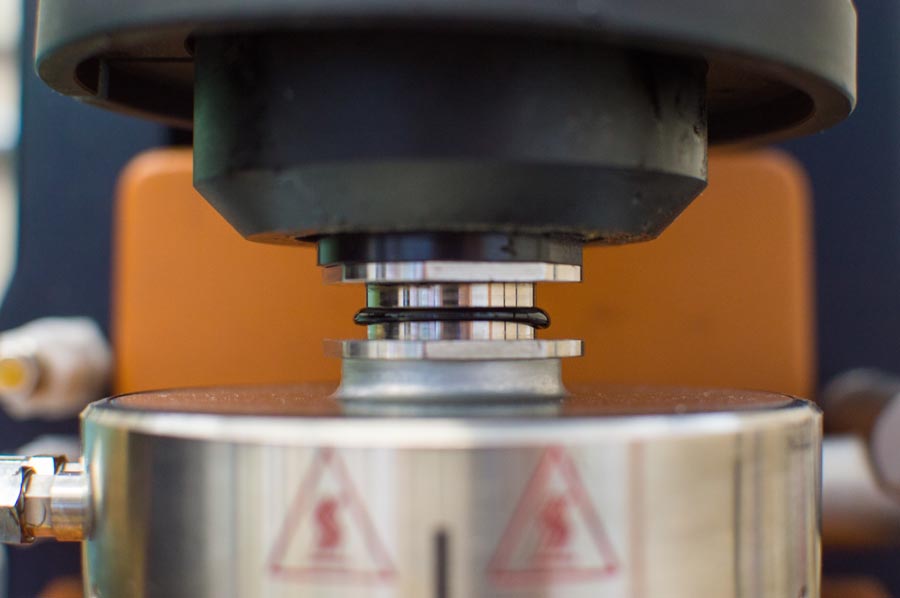SBR Latex Polymers

ULTRAPAVE SBR LATEX POLYMERS FOR ASPHALT MODIFICATION
Today’s increasing loads, greater traffic volume and the need for better, longer-lasting roads demand better service from paving materials. Asphalts modified with ULTRAPAVE© SBR Latex Polymers offer the best method of improving binders for highway, street and airport paving and maintenance projects.
ULTRAPAVE© SBR Latex Polymers were created specifically for modifying asphalt binders. ULTRAPAVE© SBR easily blends with the asphalt to form a homogenous reinforced composite and provides:
- Optimized visco-elastic properties
- Increased resistance to rutting and shoving
- Increased resistance to low temperature cracking
- Increased resistance to load-associated fatigue cracking
- Reduced temperature susceptibility
- Reduced reflective cracking
- Minimized aging effects
- Reduced stripping and raveling
PROPERTIES OF ULTRAPAVE SBR LATEX POLYMERS
ULTRAPAVE© SBR Latex Polymers contain emulsion polymerized random copolymers of styrene and butadiene in a water-based system. In latex form, the SBR particles are extremely small (averaging .5 microns), exposing a very high surface area to the asphalt for complete mixing. As a result, the physical dispersion of the polymer particles is rapid and thorough. The base polymer is also available in various molecular weights for improved asphalt compatibility if needed.
ANIONIC SBR LATEX POLYMERS
(For Polymer Modified Asphalt)
| Product | UP 70 | UP 72 | UP 74 | UP 76 | UP 7289 |
| % Solids Content,(+/- 2.0) | 70.0 | 70.0 | 70.0 | 70.0 | 70.0 |
| pH, (+/- 0.5) | 10.0 | 10.0 | 10.0 | 10.0 | 10.0 |
| Viscosity, Brookfield | 1500 | 1500 | 1500 | 1300 | 1600 |
| Monomer Ratio,(Styrene/Butadiene) | 24/76 | 24/76 | 24/76 | 24/76 | 24/76 |
(**Values are typical and not meant to be specifications.)
Heat and mechanical agitation with time produce a homogenous blend of polymer in the asphalt. As the latex is added, the polymer particles swell from the heat and solvating effects of the resins and oils in the asphalt. A micro-network forms with the polymer producing enhanced rheological properties.
PERFORMANCE-BASED BINDER SPECIFICATION TESTING
With the implementation of Superpave, a product of the Strategic Highway Research Program (SHRP), the use of rheological engineering properties to describe asphalt cement performance has become essential. TRCC has played a major role in the testing and understanding of these specifications. With over 1,000 different binder systems characterized, the effect of SBR Latex Polymers on different asphalt binders is well understood. Presentations have been made to numerous Departments of Transportation, contractors and asphalt suppliers to assist these groups with understanding the specifications and use of SBR Latex Polymers to enhance the asphalt’s properties.
The Superpave binder (AASHTO MP1) performance grade requirements provide the materials engineer with better guidelines for creating the optimum polymer-modified asphalt cement. The extensive testing capabilities of ULTRAPAVE© are available to assist the customer in developing the best system. A wide range of SBR Latex Polymers can be used in unique formulations with different asphalt cements to produce the ideal performance grade.
RESISTANCE TO HIGH TEMPERATURE PERMANENT DEFORMATION
Although the binder is not the primary cause of rutting and shoving in asphalt concrete pavements, it does play a significant role. The use of ULTRAPAVE© SBR Latex Polymers helps reduce the frequency and severity of permanent deformation. TRCC does this by increasing the elastic nature of the binder at high temperatures. The increased elasticity of the binder allows the system to recover more readily from deformations than unmodified systems. For example, the addition of SBR Latex can significantly increase the high temperature stiffness (G*/Sin Delta) over the same unmodified system.
LOW TEMPERATURE THERMAL CRACKING
One of the most beneficial aspects of polymer modification is the reduction in the modified asphalt’s low temperature stiffness. Extensive laboratory testing has shown that TRCC SBR Latex Polymers can reduce the low temperature stiffness, greatly reducing the chances of thermal cracking. Tests performed on mixtures also show that the temperature where thermal stress exceeds the tensile strength of the mixture is significantly lower (15 ° C) for SBR Latex modified mixtures as compared to unmodified mixtures.
RESISTANCE TO SHORT AND LONG TERM AGING
The addition of ULTRAPAVE© SBR reduces the thermal and oxidative aging effects which occur in the asphalt cement. The SBR modified binder shows an improvement in properties over unmodified asphalt. With the incorporation of the Pressure Aging Vessel, estimates of the long-term aging properties can be made. SBR Latex Polymers show dramatically lower long-term aging, which emphasizes the durability of the binder. The reduction in aging effects greatly increases the life of the pavement, and ultimately reduces the life cycle cost of the pavement structure.
TEMPERATURE SUSCEPTIBILITY
One of the advantages of using SBR Latex Polymers is the reduction in the temperature susceptibility. At high temperatures, the modified binder shows much higher stiffness. Modification ensures high flexibility at low temperatures, and greater visco-elasticity at high temperatures.
RESISTANCE TO STRIPPING AND RAVELING
Engineers and agency personnel have found that using SBR Latex Polymers for modified asphalt projects reduces the tendency of the binder to strip from problem aggregates. This finding is supported by extensive lab testing and limited field evaluations of new latex polymers.
CUSTOMER SUPPORT – BINDER DESIGN OPTIMIZATION
The TRCC team has a complete Superpave binder laboratory to perform testing on asphalt binders. TRCC personnel will develop the optimum binder for your application by maximizing the performance grade for that particular system. It is the belief of TRCC that each binder can be engineered with the appropriate SBR Latex Polymers to meet desired properties. Our database with over 2,000 entries attests to our experience with different source asphalts supplied by asphalt suppliers and Departments of Transportation. ULTRAPAVE© presentations on the incorporation properties and performance of SBR Latex Polymers are available to user agencies.
These presentations have been very useful in understanding the Superpave performance grade specification and the enhanced properties of SBR Latex Polymers.
SBR LATEX POLYMERS SPECIFIED IN AIRPORT PAVEMENTS
Many states routinely use SBR Latex Polymers as additives in hot-mix asphalt pavements for roads and airports. Airports use them to help prevent thermal cracking, stripping and reflective cracking. Airport authorities noted that the use of SBR Latex allowed more binder in the mixture, thus increasing durability. It was also noted that successful porous friction courses were attained with SBR Latex Polymers.
METHODS OF MODIFICATION
Another advantage of using SBR Latex Polymers as an asphalt modifier is that they can be added to any stage of the paving chain – from the refinery to the on-site job location. Major changes in technique are not required.
ASPHALT CEMENTS
ULTRAPAVE© can be added at the terminal, refinery, or at the asphalt plant through batch or drum mixers. Call your TRCC representative for specific information on quantities and methods of addition.
ASPHALT EMULSIONS
The ULTRAPAVE© SBR Latex Polymer family contains two types of emulsions, each with variations of latex polymers. Cationic latex polymers modify cationic emulsions, while anionic latex polymers can modify asphalt cements and anionic emulsions.
CATIONIC SBR LATEX POLYMERS
(For Cationic Polymer Modified Asphalt Emulsion Applications)
| Product | UP-65K | UP-1156 | UP-1158 | UP 1159 |
| % Solids Content,(+/- 1.0) | 65.0 | 65.0 | 65.0 | 65.0 |
| pH, (+/- 0.5) | 5.0 | 5.0 | 5.0 | 5.0 |
| Viscosity, Brookfield | 900 | 1000 | 1200 | 1050 |
| Monomer Ratio,(Styrene/Butadiene) | 24/76 | 24/76 | 24/76 | 24/76 |
(**Values are typical and not meant to be specifications.)
ANIONIC SBR LATEX POLYMERS
(For Anionic Polymer Modified Asphalt Emulsion Applications)
| Product | UP 70 | UP 72 | UP 74 | UP 76 | |
| % Solids Content,(+/- 2.0) | 70.0 | 70.0 | 70.0 | 70.0 | |
| pH, (+/- 0.5) | 10.0 | 10.0 | 10.0 | 10.0 | |
| Viscosity, Brookfield | 1500 | 1500 | 1500 | 1300 | |
| Monomer Ratio,(Styrene/Butadiene) | 24/76 | 24/76 | 24/76 | 24/76 |
(**Values are typical and not meant to be specifications.)
ULTRAPAVE© is easily co-milled into the emulsion as it is manufactured. Choose TRCC 70 Series for anionic emulsions, or one of our cationic latexes for cationic emulsions.
A COST-EFFECTIVE WAY TO PROLONG PAVEMENT LIFE
Blend ULTRAPAVE© Latex Polymers with asphalt paving materials for longer-lasting highways and lower maintenance costs. Only small amounts of ULTRAPAVE© are required, making the improvements extremely cost effective.
